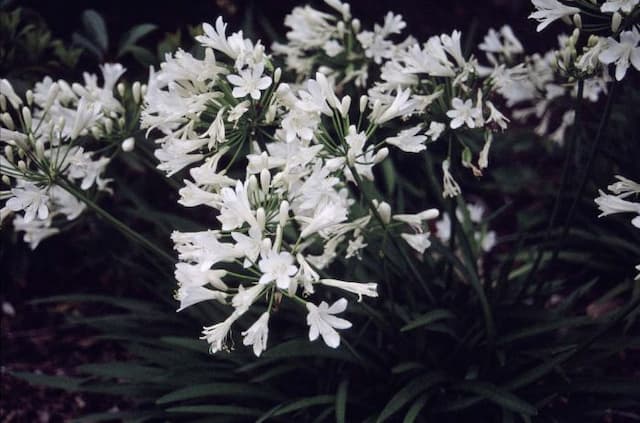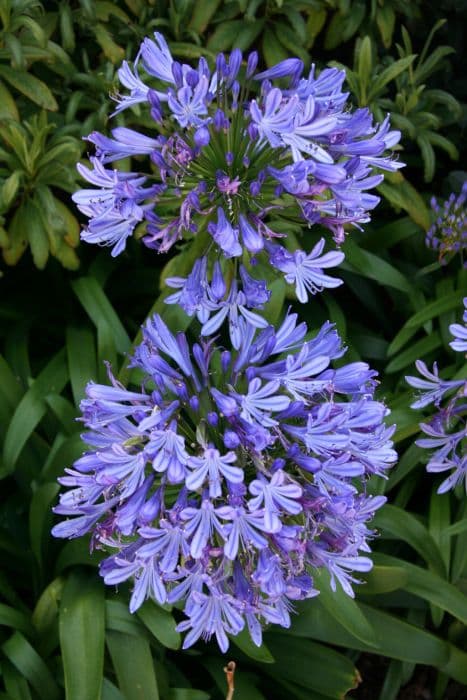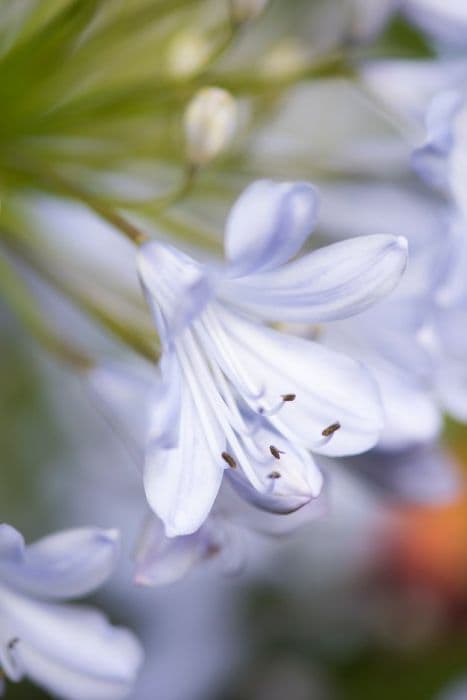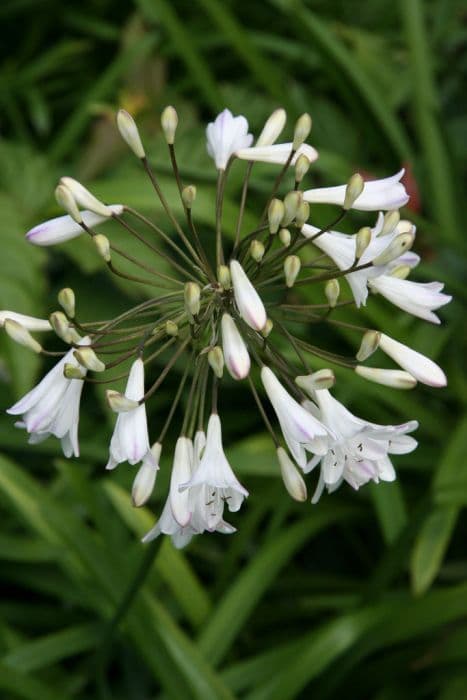African Lily Agapanthus 'Buckingham Palace'

ABOUT
Agapanthus 'Buckingham Palace' is an ornamental plant known for its striking features and is commonly called African Lily or Lily of the Nile. This perennial showcases lush, strap-shaped green leaves that create an elegant and dense clump, forming a lustrous backdrop for its stunning flower stalks. The foliage gracefully arches outward, adding to its visual appeal. The African Lily is most renowned for its impressive globular clusters of flowers, which are perched on top of tall, sturdy stalks that rise gracefully above the foliage. These flower heads are an eye-catching display of trumpet-shaped blossoms, typically a beautiful shade of vibrant blue or sometimes white. The individual flowers are funnel-like in form, neatly arranged in a spherical pattern to make up the larger, ball-shaped inflorescence. Each petal is smooth and may have a darker or lighter shade of blue along its midrib, adding depth and contrast to the flower cluster. The blossoms attract a variety of pollinators such as bees and butterflies, adding an extra dimension of life to the garden space. Although this description avoids the mention of the size of Agapanthus 'Buckingham Palace,' it is worth noting that the plant is well-suited to thrive in a variety of garden settings and containers where its showy blooms can be a focal point during its flowering season. Its overall striking presence is due to its combination of lush foliage and captivating floral spheres.
About this plant
 Names
NamesFamily
Amaryllidaceae
Synonyms
African Lily, Lily of the Nile, Love Flower
Common names
Agapanthus 'Buckingham Palace'
 Toxicity
ToxicityTo humans
The plant commonly known as Agapanthus may have toxic parts. Though not highly toxic, ingestion can potentially cause gastrointestinal symptoms such as nausea, vomiting, and diarrhea. The sap of the plant can also cause skin irritation or allergic reactions in some individuals. It is advisable to handle this plant with care and ensure it is not ingested, particularly by children or vulnerable individuals.
To pets
Agapanthus is recognized as a plant that can be toxic to pets. If ingested, it can cause symptoms such as vomiting, diarrhea, and possibly drooling in cats and dogs. Ingesting large quantities might result in more severe reactions. It is best to keep this plant out of reach of pets to avoid any accidental ingestion.
 Characteristics
CharacteristicsLife cycle
Perennials
Foliage type
Evergreen
Color of leaves
Green
Flower color
Blue
Height
2-3 feet (60-90 cm)
Spread
2-3 feet (60-90 cm)
Plant type
Bulb
Hardiness zones
8
Native area
South Africa
Benefits
 General Benefits
General Benefits- Ornamental Value: Adds aesthetic appeal to gardens with its tall, graceful flower stalks and clusters of blue or white blooms.
- Low Maintenance: Requires minimal care once established, making it a suitable choice for busy gardeners or those with less gardening experience.
- Drought Tolerance: Can survive periods of low water, reducing the need for frequent watering.
- Long Blooming Season: Offers a long period of flowering, often from early summer until the fall.
- Attracts Wildlife: The flowers attract bees, butterflies, and other pollinators, supporting local ecosystems.
- Perennial Growth: Comes back year after year, providing long-term value and reducing the need to plant annually.
- Easy to Propagate: Can be propagated easily through division, allowing gardeners to multiply their plants without additional cost.
- Can Be Container Grown: Suitable for growth in containers, making it versatile for people with limited ground space such as terraces or patios.
- Resistant to Pests: Generally resistant to pests, reducing the need for chemical treatments.
- Deer Resistant: Less likely to be eaten by deer, which is beneficial in areas where deer predation is a problem.
- Suitable for Cut Flowers: The blooms can be used in floral arrangements, providing a home-grown source of decorative flowers.
 Medical Properties
Medical PropertiesThis plant is not used for medical purposes.
 Air-purifying Qualities
Air-purifying QualitiesThis plant is not specifically known for air purifying qualities.
 Other Uses
Other Uses- Photographic Backdrop: Agapanthus flowers, with their striking blue color, can create an appealing background for close-up photographs of insects or other small subjects.
- Natural Dye: The blue flowers of the Agapanthus may be used to create natural dyes for fabrics or paper, offering a chemical-free alternative to synthetic dyes.
- Edging Plants: Agapanthus can be planted in rows to serve as a natural and attractive border along walkways or to define garden spaces.
- Garden Thematic Element: The distinctive appearance of Agapanthus can be used to contribute to a “blue-themed” garden or a coastal garden design scheme.
- Erosion Control: Using Agapanthus on slopes or areas prone to erosion can help stabilize the soil with their root systems.
- Garden Sculpture: When dried, the flower heads of Agapanthus can be used to create eco-friendly garden sculptures or artistic arrangements.
- Floating Decorations: Individual Agapanthus flowers can float in bowls of water, creating simple and elegant decorative features for garden parties or weddings.
- Bookmark Crafting: Pressed Agapanthus flowers can be laminated or encased in clear resin to create natural, floral bookmarks.
- Gift Wrapping Embellishment: Fresh or dried Agapanthus flowers can be used to decorate gift wraps, adding a personal and botanical touch to presents.
- Floral Art: Agapanthus can be used in floral art, such as creating botanical mandalas or other shapes for contemplative or decorative purposes.
Interesting Facts
 Feng Shui
Feng ShuiThe Lily of the Nile is not used in Feng Shui practice.
 Zodiac Sign Compitability
Zodiac Sign CompitabilityThe Lily of the Nile is not used in astrology practice.
 Plant Symbolism
Plant Symbolism- Love Letters: The name 'Agapanthus' is derived from the Greek words 'agape' meaning love, and 'anthos' meaning flower, symbolizing a message of love or a love letter.
- Beauty: Often found in royal gardens and elegant arrangements, Agapanthus is associated with beauty and a regal presence, as hinted by the cultivar name 'Buckingham Palace'.
- Fertility: With its lush, green foliage and round clusters of flowers, Agapanthus can symbolize fertility and abundance.
- Enduring Love: The plant's ability to thrive and bloom every year is seen as a representation of enduring or long-lasting love.
- Home: It is also commonly associated with domestic happiness and creating a welcoming home, as it is often used in ornamental gardens.
 Water
WaterAfrican Lily requires consistent watering to keep the soil evenly moist but not waterlogged. During the growing season, water regularly, about once a week, providing enough water to soak the roots which might be approximately 1-2 gallons per plant depending on size and environmental conditions. Reduce watering in the winter when the plant is dormant, allowing the top inch of soil to dry out between watering sessions. Always check the soil moisture before watering to ensure the plant is not overwatered, as this can lead to root rot.
 Light
LightAfrican Lily thrives best in full sun to partial shade conditions. An ideal spot is one where the plant receives at least 6 hours of direct sunlight daily but is shielded from the harsh afternoon sun. In regions with very hot summers, some afternoon shade will help prevent leaf scorch. Proper exposure to light ensures healthy growth and a profusion of blooms.
 Temperature
TemperatureAfrican Lily prefers mild to warm temperatures, with ideal growing conditions between 60°F and 80°F. It can tolerate a brief dip down to about 50°F, but temperatures below this can cause damage or kill the plant. In climates with cold winters, it's best to grow African Lilies in containers that can be moved indoors or provide adequate mulch to protect them from freezing temperatures.
 Pruning
PruningPrune African Lily after flowering by removing spent flower stalks to promote a tidy appearance and encourage more blooms. Cut back the foliage only when it begins to die back naturally in the fall. The best time to prune is when the flowering period has ended, which typically occurs by late summer or early fall.
 Cleaning
CleaningAs needed
 Soil
SoilThe African Lily 'Buckingham Palace' prefers well-draining soil with a mix of potting soil, compost, and perlite or sand. The ideal pH for this soil mix should be between 6.0 and 8.0 to ensure a healthy growth environment.
 Repotting
RepottingAfrican Lily 'Buckingham Palace' should be repotted every 2 to 3 years to refresh the soil and accommodate its growing root system. Avoid too frequent repotting as they bloom best when slightly root-bound.
 Humidity & Misting
Humidity & MistingAfrican Lily 'Buckingham Palace' flourishes in average room humidity levels. It does not require a high humidity environment; normal indoor humidity levels are generally adequate for its growth.
 Suitable locations
Suitable locationsIndoor
Place in bright indirect light and water when top soil is dry.
Outdoor
Plant in partial sun, shelter from strong winds, water regularly.
Hardiness zone
8-11 USDA
 Life cycle
Life cycleThe life cycle of the Agapanthus 'Buckingham Palace', commonly known as the Lily of the Nile, begins with seed germination, which requires a warm environment and can take several weeks to months. Once the seedlings emerge and develop true leaves, they enter the vegetative growth phase where they establish a strong root system and foliage. As the plant matures, it enters the flowering stage, typically during the summer months, producing tall stalks topped with clusters of blue or white flowers. After flowering, the plant produces seed pods that, when dried, release seeds to propagate the next generation. During the winter, the Agapanthus may die back, especially in colder climates, entering a period of dormancy where underground rhizomes or bulbs survive until spring. With the return of favorable growing conditions, the plant resumes growth, completing its perennial cycle.
 Propogation
PropogationPropogation time
Late spring-Early summer
Agapanthus 'Buckingham Palace', commonly known as African lily or Lily of the Nile, is best propagated by dividing established clumps. Division is ideally done in the spring or early summer as the plant emerges from dormancy and before it has put on significant new growth. To propagate by division, carefully dig up the plant, and then gently separate the clump into smaller sections, each with a portion of the root system and several shoots. These divisions can be immediately replanted into well-draining soil at the same depth they were growing previously. Water the new divisions well to help establish them. Mulching can help retain moisture and reduce temperature fluctuations as the new plants settle in.




![African lily [Blue Storm]](/_next/image?url=https%3A%2F%2Fplants-admin.emdemapps.com%2Fimages%2Fplants%2F%2Fimages%2F604b63200a08b.png&w=640&q=75)




